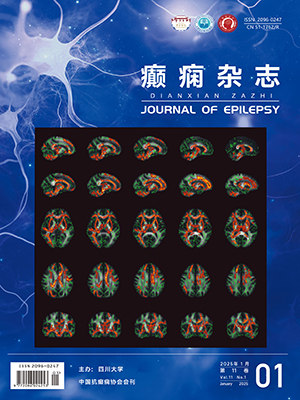| 1. |
Wiseman H, Reuber M. New insights into psychogenic nonepileptic seizures 2011-2014. Seizure, 2015, 29: 69-80.
|
| 2. |
Edwards MJ, Adams RA, Brown H, et al. A Bayesian account of ‘hysteria’. Brain, 2012, 135(Pt 11): 3495-3512.
|
| 3. |
Kwan P, Arzimanoglou A, Berg AT, et al. Definition of drug resistant epilepsy: consensus proposal by thead hoc Task Force of the ILAE Commission on Therapeutic Strategies. Epilepsia, 2010, 51(6): 1069-1077.
|
| 4. |
Reuber M, Pukrop R, Bauer J, et al. Outcome in psychogenic nonepileptic seizures: 1 to 10-year follow-up in 164 patients. Ann Neurol, 2003, 53(3): 305-311.
|
| 5. |
Brown RJ, Reuber M. Psychological and psychiatric aspects of psychogenic non-epileptic seizures (PNES): a systematic review. Clin Psychol Rev, 2016, 45: 157-182.
|
| 6. |
Mula M. Cognitive dysfunction in patients with epilepsy: focus on clinical variables. Fut Neurol, 2015, 10: 41-48.
|
| 7. |
Reuber M. Are psychogenic non-epileptic seizures an expression of " neurologic” pathology?”. London: Academic Press, 2008: 153-177.
|
| 8. |
Tellez-Zenteno JF, Patten SB, Jette N, et al. Psychiatric comorbidity in epilepsy: a population-based analysis. Epilepsia, 2007, 48(12): 2336-2344.
|
| 9. |
Fisher RS, Acevedo C, Arzimanoglou A, et al. ILAE official report: a practical clinical definition of epilepsy. Epilepsia, 2014, 55(4): 475-482.
|
| 10. |
Jacoby A, Snape D, Baker GA. Determinants of quality of life in people with epilepsy. Neurol Clin, 2009, 27(4): 843-863.
|
| 11. |
Jones B, Reuber M, Norman P. Correlates of health-related quality of life in adults with psychogenic nonepileptic seizures: A systematic review. Epilepsia, 2016, 57(2): 171-181.
|
| 12. |
Michaelis R, Tang V, Wagner JL, et al. Psychological treatment for people with epilepsy. The Cochrane data base of systematicreviews, 2017, 10: CD012081.
|
| 13. |
Carlson P, Perry KN. Psychological interventions for psychogenic non-epileptic seizures: A meta-analysis. Seizure, 2017, 45: 142-150.
|
| 14. |
LaFrance WC, Reuber M, Goldstein LH. Management of psychogenic nonepileptic seizures. Epilepsia, 2013, 54(Suppl 1): 53-67.
|
| 15. |
Kanemoto K, LaFrance WC, Duncan R, et al. PNES around the world: where we are now and how we can close the diagnosis and treatment gaps. An ILAE PNES Task Force report. Epilepsia Open, 2017, 2(3): 307-316.
|
| 16. |
LaFrance WC, Rusch MD, Machan JT. What is " treatment asusual” for nonepileptic seizures?. Epilepsy Behav, 2008, 12(3): 388-394.
|
| 17. |
Mayor R, Smith PE, Reuber M. Management of patients with nonepileptic attack disorder in the United Kingdom: a survey of health care professionals. Epilepsy Behav, 2011, 21(4): 402-406.
|
| 18. |
LaFrance WCJr, Wincze JP. Treating nonepileptic seizures: therapist guide. Oxford, UK: Oxford University Press, 2015.
|
| 19. |
Butler AC, Chapman JE, Forman EM, et al. The empirical status of cognitive-behavioral therapy: a review of meta-analyses. Clin Psychol Rev, 2006, 26(1): 17-31.
|
| 20. |
Hayes SC, Luoma JB, Bond FW, et al. Acceptance and commitment therapy: Model, processes and outcomes. Behav Res Ther, 2006, 44(1): 1-25.
|
| 21. |
Graham CD, Gouick J, Krahe C, et al. A systematic review ofthe use of Acceptance and Commitment Therapy (ACT) inchronic disease and long-term conditions. Clin Psychol Rev, 2016, 30: 46-58.
|
| 22. |
Dewhurst E, Novakova B, Reuber M. A prospective service evaluation of acceptance and commitment therapy for patients with refractory epilepsy. Epilepsy Behav, 2015, 46: 234-241.
|
| 23. |
Hobson RF. Forms of feeling: the heart of psychotherapy. London, UK: Tavistock, 1985.
|
| 24. |
Ogden P, Pain C, Fisher J. A sensorimotor approach to the treatment of trauma and dissociation. Psychiatric Clin, 2006, 29(1): 263-279.
|
| 25. |
Rothschild B. Trauma essentials: the go-to guide (go-to guides for mental health). New York, NY: WW Norton & Company, 2011.
|
| 26. |
Howlett S, Reuber M. An augmented model of brief psychodynamic interpersonal therapy for patients with nonepileptic seizures. Psychotherapy (Chic), 2009, 46(1): 125-138.
|
| 27. |
Brown RJ, Reuber M. Towards an integrative theory of psychogenic non-epileptic seizures (PNES). ClinPsychol Rev, 2016, 47: 55-70.
|
| 28. |
Reuber M, Brown RJ. Understanding psychogenic nonepilepticseizures-Phenomenology, semiologyand the integrative cognitive model. Seizure, 2017, 44: 199-205.
|
| 29. |
Myers L, Vaidya-Mathur U, Lancman M. Prolonged exposuretherapy for the treatment of patientsdiagnosed with psychogenicnon-epileptic seizures (PNES) and post-traumatic stress disorder(PTSD). Epilepsy Behav, 2017, 31: 86-92.
|
| 30. |
Asadi-Pooya AA, Emami M, Emami Y. Ictal injury in psychogenic non-epileptic seizures. Seizure, 2014, 23(5): 363-366.
|
| 31. |
Nguyen R, Zenteno JF. Injuries in epilepsy: a review of its prevalence, risk factors, type of injuries andprevention. Neurol Int, 2009, 1(1): e20.
|
| 32. |
Peguero E, Abou-Khalil B, Fakhoury T, et al. Self-injury and incontinence in psychogenic seizures. Epilepsia, 1995, 36(6): 586-591.
|
| 33. |
Worsely C, Whitehead K, Kandler R, et al. Illness perceptions of health care workers in relation to epileptic and psychogenic nonepileptic seizures. Epilepsy Behav, 2011, 20(4): 668-673.
|




